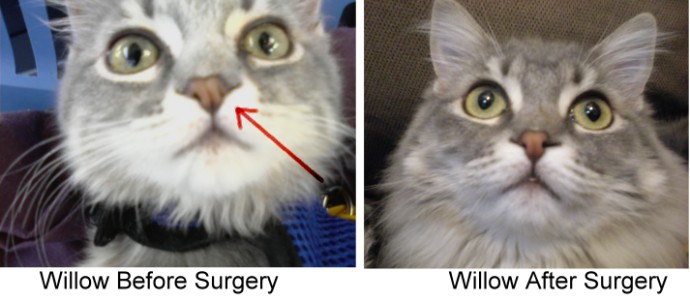
FELINE MEDICAL CURIOSITIES: MUZZLE AND MOUTH
Cleft Palate, Anomalies of the Mouth and Muzzle
Note: Contrary to suggestions on some bulletin boards, the images here are not photoshop. With the exception of those labelled as artist's impressions these are photos of medical conditions. These pages are intended as a medical reference site. Offsite links to images on these pages is not supported - bandwidth costs money!
WHISKERS
Many cats have impressive whiskers. The longest whiskers belong to a female Maine Coon called Mingo, owned by Marina Merne of Turku, Finland. In July 2004, one of Mingo's whiskers measured 6.8 inches (17.4 cm). Admittedly, not many owners have bothered to measure their cats' whiskers.
Rex-furred cats frequently have curly whiskers as well as curly fur. Usually the whiskers form long, looping curls although in some Rex breeds the whiskers are so brittle that they break easily, leaving the cat with short stubble.
NOSTRILS
Caleb Kinser wrote in 2009 of his grandmothers recent litter of kittens which included a cat with only one nostril. The side where the other nostril should have been was simply covered by fur. There seem to be no ill effects. There was no indication of whther the whole nasal passage was missing or whether just the nose leather was affected so there was no opening of the nasal passage.
|
|
Kobi provided these 2 photos of Willow before and after surgery to correct a twisted nose with an obstructed nostril (shown by the red arrow). Willow is a mixed breed that was born with moderate brachycephaly (short face), stenotic nares and a deviated septum (blocked and twisted nasal passages causing noisy breathing and tears running from the eye because of a blocked tear-duct). She had surgery at a specialist center to repair the stenotic nares at about 4 months of age, which involved removing two small triangular portions of her nose to open up her nostrils. She was 8 months old at the time of the second photo and doing well, though she may require another surgery in the future as her nose grows.
The kitten below has uneven nostrils (possibly very mild hare lip) and also has a kink in her tail and the middle toes of her front right paw fused together. Apart from these minor oddities, she is perfectly normal in her development and behaviour.
|
|
UNEVEN FACIAL DEVELOPMENT
|
|
Sarah Saylor provided these photos of a 5 and a half week old kitten "Batty Cat" with facial deformites. It appears that one side of Batty's face hasn't developed as fully as the other side - giving him a smaller eye and twisting his nose and mouth to one side. As long as he can eat and drink normally and the rest of his body is unaffected by developmental deformities, Batty should have a normal life. The cleft lip is cosmetic and there is no cleft palate; the lip could be repaired surgically if it caused any problems. The twisting of the nose could cause noisy or obstructed breathing, but that could be helped by surgery. One eye is under-developed and appears to have limited sight. As Batty grows, a vet will need to check his jaw alignment (it may grow unevenly) in case there's any twisting or under-development on one side in which case he might need some adult teeth removed to avoid over-crowding. Batty was otherwise in good health and had a good appetite, though it has been a little harder for him to move onto soft food due. He was bottle-fed from birth.
DOUBLE CANINE TEETH
Anastopoulos Thanos of Sparti, Greece provided images and details of a double canine tooth: "A few months ago I adopted a pair of stray kittens found on the street outside my house. 1 female and 1 male. They have developed a liking to the indoors. Another issue concerning the male cat. The upper left fang is actually 2 fangs. The cat is approx 4 months old. The 2nd tooth is thinner and broken at the tip." An explanation for these double fangs, which are not uncommon, is provided below the photos.

Veterinary dentist’s assistant Denise DeForge in the United States provided additional information about the double canine teeth. In the case of the Sparti cat, this is a common occurrence called "retained deciduous teeth". At about 4 to 5 months of age, the kitten should shed its deciduous (baby) teeth which are pushed out by the permanent adult teeth. Sometimes the two sets of teeth (deciduous and adult) end up are growing side by side, with the thinner, more sharply pointed, tooth being the baby tooth. If the baby tooth doesn’t fall out, it should be extracted to prevent damage to the adult tooth bud which is trying to grow in.
As well as retained baby teeth, there are other anomalies of the oral cavity. One anomaly is "supernumerary teeth" (as found in throwback “Thumper” mentioned below) which are legitimately two sets of adult teeth growing side by side. This was observed in Denise’s cat at about 9 months of age. Food would 'hang' out of his mouth after eating and when she investigated, she found he had two sets of adult molar teeth. The second set of molars were extracted to prevent decay from occurring from food caught between the two sets of teeth. Unfortunately no photos were taken.
Another case of double canine teeth is noted on the curiosities page dealing with throwbacks relating to "Thumper", whose supernumerary canines were noted by a vet.
|
Impacted canines (Lizzie Ellis) |
Lizzie Ellis of The Feline Rescue Association Inc, Maryland, USA, provided these images of double teeth. The imapacted canine teeth were later surgically removed.
PORPHYRIA
Porphyria is a hereditary disease where there is abnormal metabolism of the blood pigment haemoglobin. Porphyrins are excreted in the urine, which becomes dark, and the teeth and claws are red and glow under UV light. Cutaneous porphyria, Erythropoietic Porphyria (Gunther's disease) and Intrmittent Porphyria have been seen in cats.

HARE LIP
Susanne Farrar in central Arkansas, USA, provided this photo of 4 year old Sweetie who has hare lip, but no cleft palate. Sweetie was adopted from a shelter (the clipped ear was done erroneously by a vet marking her as a neutered feral).
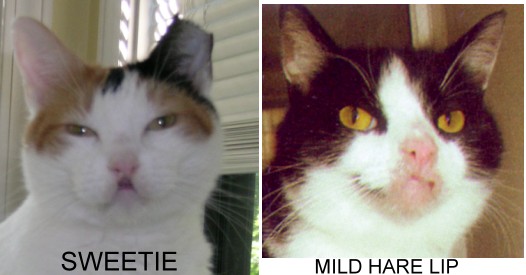
In 2016, Angie Renwick of Ottawa, Ontario, sent these photos of Edgar, a kitten with a hare lip. Sadly Edagar died at 6 months due to FIP. He ate and drank well, but occasionally got water in his "face hole" and would sneeze. Angie cleaned it with a cotton swab and warm water. His teeth came in crooked and pushed to one side, and it's likely some would have had to been removed had he lived to adulthood. Angie adopted him at 12 weeks from a rescue in Smiths Falls, Ontario. He was born to a barn cat and had at least one sister, apparently completely normal. He was a bit shy, but very sweet and popular at his vet's office where everyone always wanted to meet him and get a look at his funny face.
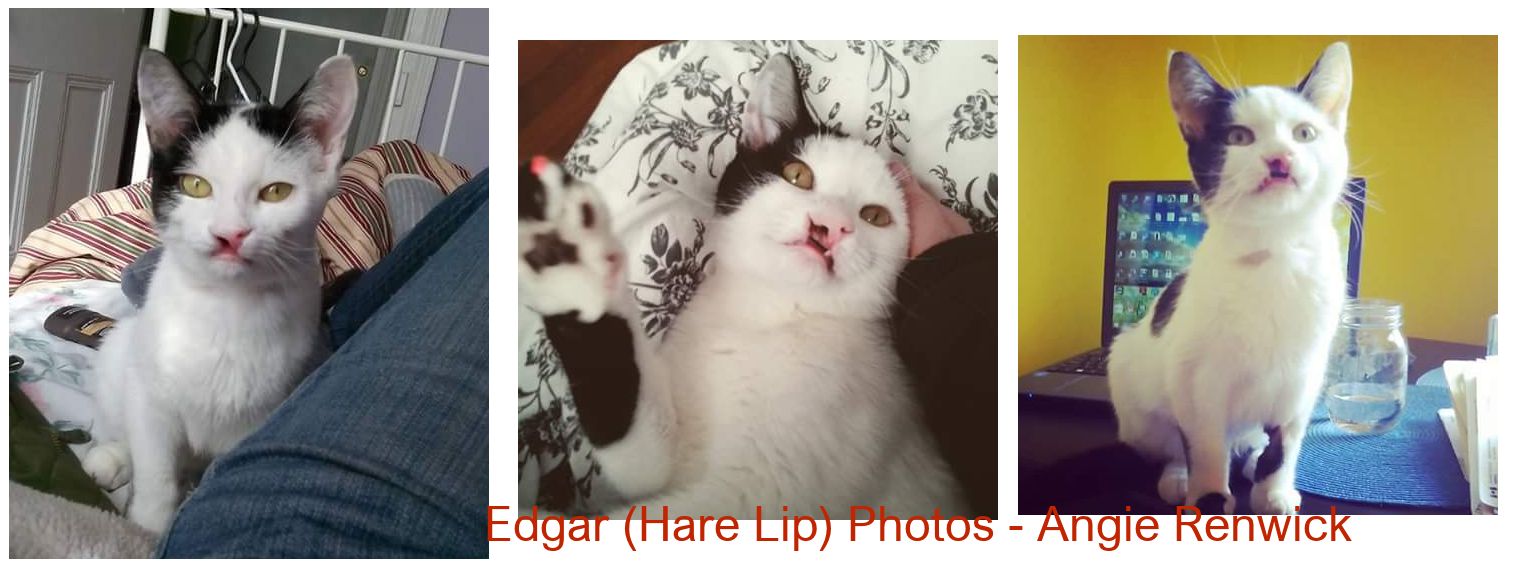
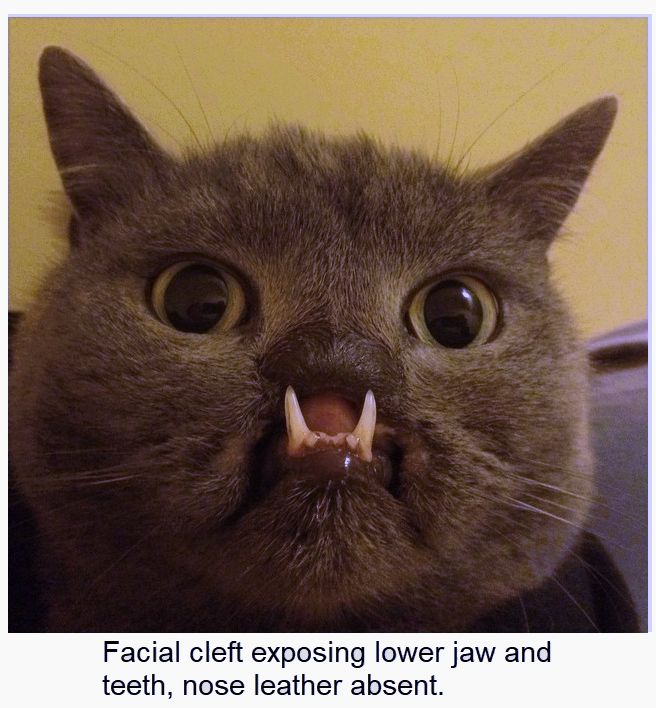
CLEFT PALATE
Kittens born with cleft palate and associated hare lip frequently don't survive because they are unable to suckle properly. Instead of reaching their oesophagus, the milk goes straight back out of the nose. Such kittens must be tube fed in order to survive and the cleft palate must be surgically repaired. Hare lip is often seen with cleft palate cases, and Merlin (below) is showing his hare lip. Merlin's owner is Alisha Pierce, NC, USA who sent Merlin's photo to Messybeast.com. She says "I noticed there was no mention of cats surviving after birth with cleft palate and hare lip. I have such a cat, he's about 7 years old now. None of the veterinarians I've been to had ever seen a cleft palate survivor. I've never found any studies on their survival, or even a photo of a cat such as my Merlin."
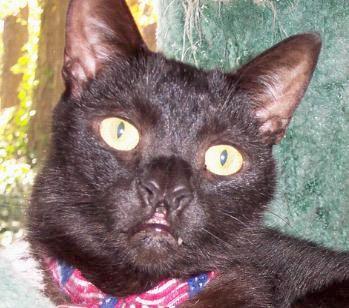
Cleft palate means that the hard and/or soft palate failed to fuse while the foetus was developing. This leaves one or more holes in the roof of the mouth connecting the mouth and nose. The degree of cleft ranges from tiny holes to a large central fissure running from the front to back of the roof of the mouth to the front of the jaw. In severe cases, it also affects the upper jaw line and causes hare-lip. In some cases, the hard and soft palates are completely absent. A hereditary cause is suspected in cats with short, broad faces. Most cleft palate cases appear to be random and are probably due to disruption of foetal development in the womb e.g. the pregnant mother is exposed to drugs, chemicals or radiation, the mother has metabolic disturbances or an infection during pregnancy.
In kittens with cleft palates, milk is forced through the holes and into the nasal passages. It trickles or bubbles out of the nostrils during and after feeding and may cause suckling kittens to sneeze. This reduces the amount of milk reaching the stomach (causing malnutrition) and diverts milk into the airways (causing respiratory problems or drowning). The bigger the hole, the worse the problems. To allow the holes to heal or be repaired, the kitten must be tube fed. Small holes often close over in 1-2 weeks, but larger holes or fissures must be surgically repaired. Smaller holes are repaired by grafting a skin flap over the hole. If surgical repair is feasible, the affected kitten must be tube fed until it is robust enough for surgery. Soft palates can be repaired at 6-8 weeks old; hard palates can be repaired at approximately 6 months old. Where the cleft is extensive, or the palates are completely absent, euthanasia is necessary.
Little is known of the mode of inheritance in cats, but breeders are advised not to breed from affected cats that survive the condition. In some dog breeds, cleft palate is an autosomal recessive genetic condition. Minor clefts or small holes in the palate can be surgically repaired. Major clefts are usually not repairable because there is insufficient tissue available to bridge the cleft..
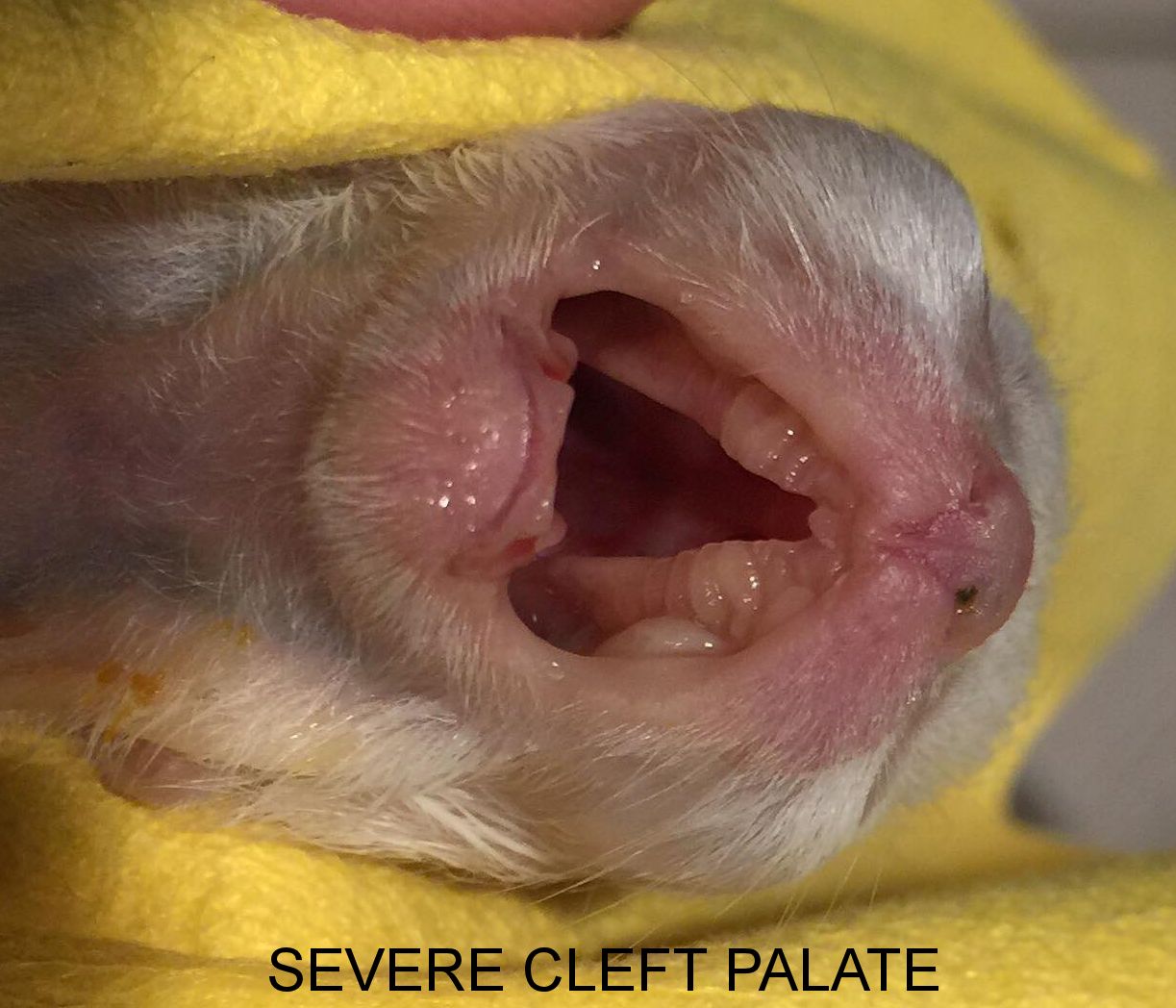
SHORT PALATE
Another mouth deformity reported to me was a short soft palate in a female Siamese cat. The cat developed normally until the age of 6 months when the palate did not completely develop. The roof of the mouth is covered, but it stops short of the top of her throat. When the cat eats, bits of food get into her nasal cavity and must be sneezed out. The cat easily becomes dehydrated in the summer and is susceptible to nasal infection, particularly in the winter, as a result of food and water entering in the nasal cavity. To prevent water from running in her nose, the cat drinks from a rodent's drinking bottle, rather than from a bowl. Apart from these problems, she is healthy and was 9 years old when I received the information from her owner, Shana Vanbebber.
Congenital shortening of the soft palate occurs in kittens and is very similar in its effects to cleft palate. Treatment is usually not practicable. Apart from this, I have found almost no information on the condition. I haven't come across the problem before and my best guess is that it may be linked to the long facial shape of the Siamese cat in the same way that palate problems are most associated with varieties with short, broad heads.
ABSENT LOWER JAW
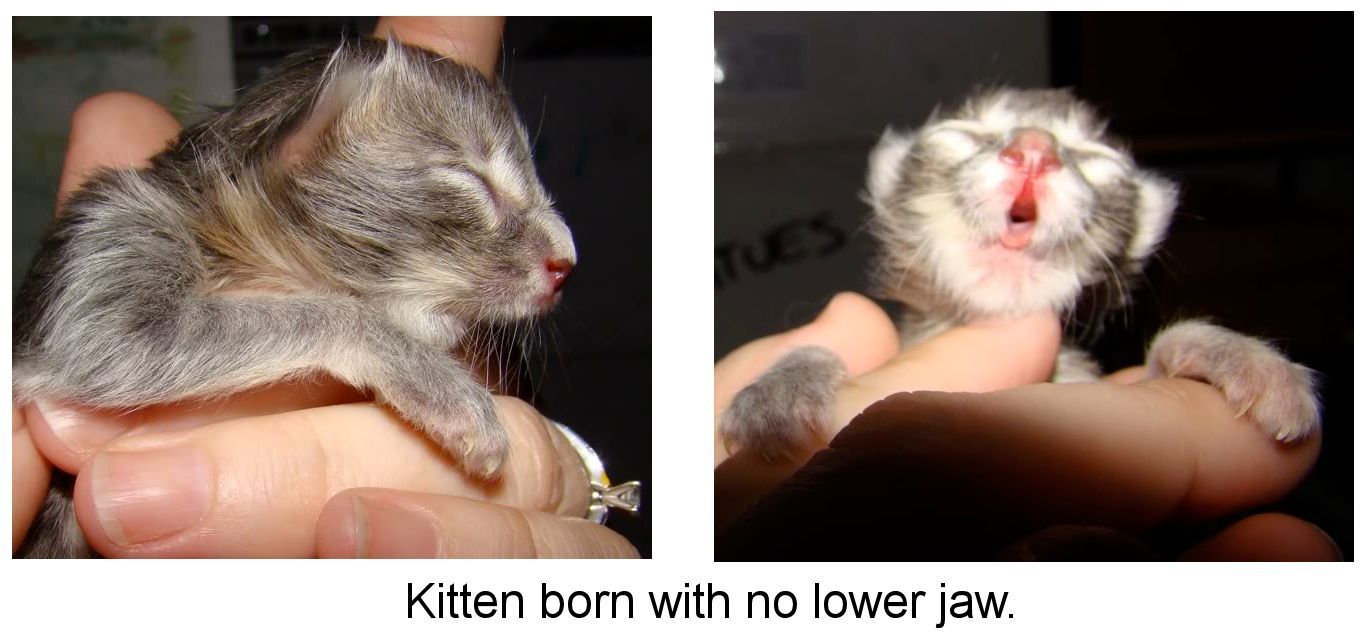
The prognosis for kittens born with an incomplete or absent lower jaw (mandible) is very poor. They cannot suckle properly. It is possible to tube feed the kitten, but it would have difficulty eating solid food later on. If enough of the jaw is present it might be possible to repair it once the kitten is old enough. It depends on whether enough bone is present to create a functioning mandible that allows the cat to eat normally. If the jaw is completely absent, euthanasia is recommended.
AGLOSSIA (ABSENT TONGUE)
Up until 2021, I knew of only one case of a cat born without a tongue and there were very few details available. It survived to adulthood (I have no information, but assume syringe or tube feeding was required to compensate for suckling problems). As an adult, it drinks by sucking water rather than lapping, though it finds a rabbit's water bottle easier to use than a bowl. It is able to eat mashed soft food. Absence of the tongue means it cannot groom itself and is liable to become unkempt. Its owners compensated by grooming the cat with a damp cloth.
In 2021, I learnt about Tilly the Tongue-less Kitty.
Tilly’s story was shared with me by owner Candy Davis, Alabama, in May 2021. Candy has several “foster fails” – cats she has permanently adopted after fostering them for a local rescue, including “wobbly cats” with cerebellar hypoplasia. Tilly the Tongue-less Kitty also has her own Facebook page which shows she has just as much zest for life as any other cat. She also has 2 different colour eyes.
Tilly was born without a tongue (isolated congenital aglossia). There are only 11 recorded cases of this in humans since 1718 and none in animals apart from the one mentioned briefly on this page. She was found on May 28, 2020 at about a week old. Her eyes were open but her ears were still closed. The couple that found her bottle fed her just like any other tiny kitten but as she got older they noticed she was not able to eat on her own. On June 20th, 2020 they took her to a vet and found that she had no tongue. So they continued to bottle feed her. A few months, they found out they were pregnant and decided to re-home Tilly as it takes a lot of work to take care of her and this would be impossible with a baby human in the house. A local rescue, Forgotten Felines, reached out and asked if Candy and her husband would foster Tilly. Candy went to meet her on Sept 23, 2020, took her home and fell in love with her, so she became a permanent member of the household.
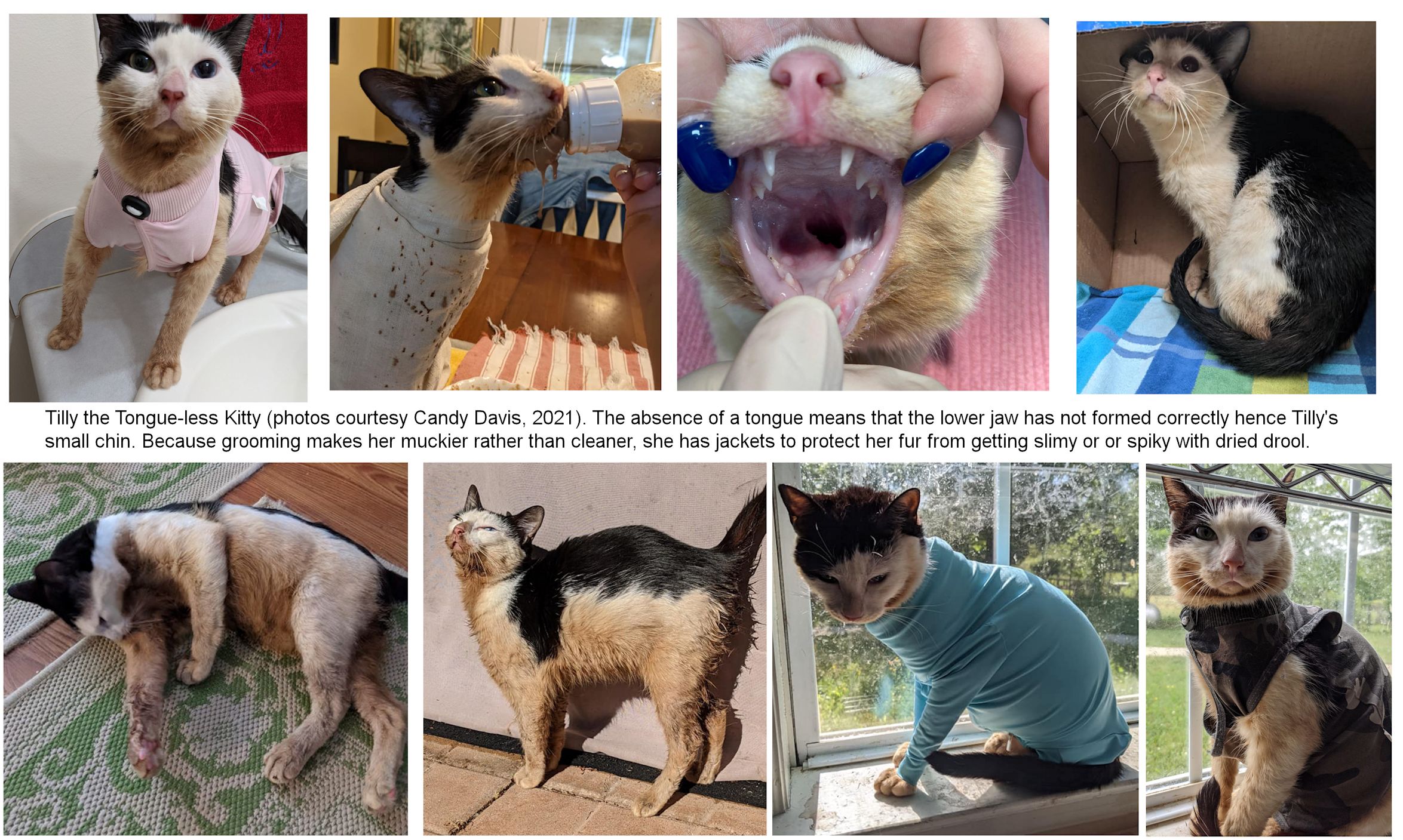
Caring for Tilly is challenging. She is bottle fed 2-3 times a day and is an enthusiastic eater even though she can’t taste the food. The food is canned food pureed with extra water (no strong smelling foods though as she tends to get this all over her) fed from a baby’s bottle with an larger hole cut in the rubber nipple (teat). She needs a cloth wrapped round her neck and chest during mealtimes as some of the food dribbles out of her mouth. She can drink from a water bowl on her own, but also has a water fountain. She sometimes tries to eat the other cats’ dry food, but without a tongue she mostly just slobbers all over it, sometimes gets a little choked and then goes to drink from the water bowl to rinse it all out of her mouth and makes a mess in the water bowl. So that means quite a lot of clearing up after her!
A cat uses its tongue when grooming itself, both to spread saliva and then to “dry” itself. Tilly can’t do this and ends up slobbering all over, staining her fur and “she looks like she slept in a mud puddle.” Candy bathes her once a week or so depending on how much "grooming" she has done. To protect her fur from being wet and stained and her skin from suffering, Tilly wears washable jackets. She doesn’t like the jackets and sometimes manages to lose them, but they are needed for hygiene purposes.
Tilly is very opinionated and funny and loves playing with toys, especially soft ones she can carry around in her mouth and then hide.
OTHER ABNORMALITIES OF THE TONGUE

In 2004, the Malaysian "Star" newspaper reported the case of a Persian kitten born with two tongues. Named Pha Pathan (Thai for "luck"), the kitten had two tongues apart from white bristle on its palate. The owner, Noraini Abdullah, of Taman Beseri Jaya (near Kangar), found the kitten was unable to suckle. Looking in the kitten's mouth, she found a second tongue located on top of the first. It was born in May 2004 to a female called Ping Pong and has three normal litter-mates. The Veterinary Services Department gave Mrs Abdullah a syringe to feed the kitten with. (Photo by: Bernamapic)
Delores Whittington of Dobson, NC, USA also has a cat with 2 tongues. "Five Toes" (so named because she also has polydactyly) is a healthy black female Burmese mix who was 4 years old in 2005. Dolores has had Five Toes since she was a kitten and notes that the parents and littermates all have the more usual complement of only one tongue. Five Toes had no trouble nursing and did not need to be hand fed. She was weaned normally. She learnt how to use both tongues straight away and has no trouble eating, cleaning herself or breathing. Dolores believes this may be due to both tongues being the same size. Five Toes can use both tongues at the same time, but can also use the both separately as well. Because she had no difficulties, Dolores didn't notice the extra tongue until very recently when she noticed Five Toes using both tongues separately to lick her chin and nose! Thinking Five Toes had injured her tongue, Dolores took her to a vet in Mt Airy. The vet pronounced Five Toes fit and well and wanted to see the tongues for himself so he touched the end of Five Toes' nose and saw her flick out both tongues! Even Dolores' husband didn't believe that their cat had 2 tongues until he saw Five Toes lick herself with both tongues (being half asleep at the time, this apparently came as quite a shock to him!).
|
Two tongues at work together. |
Two tongues at work separately - one for the chin and one for the nose. |
BLACK TONGUE
A black-tongued black cat was owned by Nickolas Heckman. The cat, which died in 2003, had black fur, black paw-pads, black-streaked teeth, golden eyes and a black tongue. She was adopted in Texas around 16 years ago. Her mother was a Siamese-type cat. This black-tongued feline had one litter of kittens, but none survived as she refused to care for them.
MORE ANOMALIES
If you have come to this page directly from a search engine, please check out
FELINE MEDICAL CURIOSITIES for the full index of topics includingBOOKS ABOUT ANOMALIES
If you are interested in medical curiosities, books worth reading are "Mutants: on the Form, Varieties and Errors of the Human Body" by Armand Marie Leroi and "Anomalies and Curiosities of Medicine Vols 1 and 2" by George M. Gould & Walter L. Pyle. The Gould & Pyle books were published in 1896 and are in the public domain. You can download text-only versions of Gould & Pyle from several websites so don't waste money on text-only versions of the book; but if you want the versions with photos, consider the Kessinger editions. The Leroi book explains why and how some deformities and anomalies happen - the mechanism is the same in cats as it is in humans.
You are visitor number